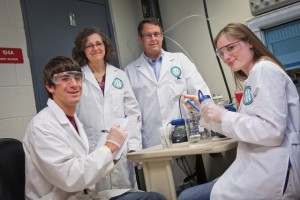
From left are Brian Peacock '12, Laurie Caslake, associate professor and head of biology, Arthur Kney, associate professor and head of civil and environmental engineering, and Annie Mikol '13.
After she graduates from Lafayette, Andrea Mikol ’13 (Wind Gap, Pa.) plans to attend graduate school to study environmental engineering. She has already started compiling an impressive resume by working on an interdisciplinary research project and making a presentation at the American Water Works Association Pennsylvania Section conference.
This was the first professional conference Mikol has attended, and she did an excellent job as the research placed second among a mix of undergraduate and graduate teams. The project, which Brian Peacock ’12 (Haddonfield, N.J.) began last summer and Mikol joined in the fall, uses colonies of bacteria, called biofilms, to remove chemicals from wetlands. Art Kney, associate professor and head of civil and environmental engineering, and Laurie Caslake, associate professor and head of biology, are advising the research.
According to Peacock, a civil engineering major, wetlands play an important role in the environment by filtering and storing water, cycling important nutrients, and as a habitat for many species. The biofilms they are using can be found naturally in the wetlands environment and are noninvasive.
“The goal of the project is to model a wetland biofilm growth and chemical transformation, primarily to be used as a tool for water and wastewater treatment technologies,” explains Mikol, an engineering studies major. “A biofilm is a complex aggregation of microorganisms that adhere to and grow on a surface, like the slime on river rocks or the plaque on your teeth. We’re mainly interested in biofilms that occur in natural wetlands, and we will initially study the chemical transformation of nitrogenous compounds through the activity of the biofilm. This is important for water and wastewater treatment technologies because an excess of nitrogen in the effluent water can cause algae blooms in the body of water in which the effluent is released, and can eventually reduce the oxygen in the water.”
Environmental engineering and biology are fields Mikol and Caslake are passionate about, and their interest in them is precisely why Peacock and Kney brought them on board.
“I’m hopeful that research like this will help find solutions to the emerging environmental problems we face today,” Mikol says. “It’s exciting to be involved in research that links two fields of study that I’m very interested in.”
Peacock is fascinated with the field of ecological engineering, which uses artificial ecosystems to treat and use waste. He plans to pursue a Ph.D. in the field and will continue his research on wetlands for his senior honors thesis. His work has garnered him two national awards: a 2011 Udall Scholarship and an Environmental Protection Agency-Greater Research Opportunity fellowship.
He believes Lafayette’s undergraduate opportunities and one-on-one attention from faculty have helped him develop the skills he’s needed to be so successful.
“The research facilities are outstanding and the small size of the school has enabled me to access all of the facilities with unprecedented ease,” says Peacock. “It has been great to work closely with professors and have the freedom to explore my own ideas.”
The flexibility of her major is a perfect fit for Mikol, who chose engineering studies so she could focus on environmental engineering classes while still gaining exposure to biology.
“Environmental engineering is a fairly broad field, and I’ve come to find that students come into the field wanting to explore a wide variety of topics,” Kney explains. “I have also found that in order to get the greatest success on a project, student interest is a very important piece of the puzzle. Annie is a great example of a student that has found her passion based on courses and hands-on activities. How lucky we are to work with such gifted students.”

1 Comment
Comments are closed.